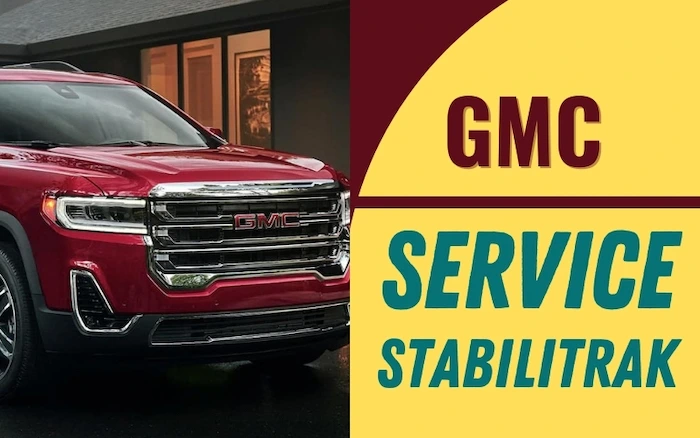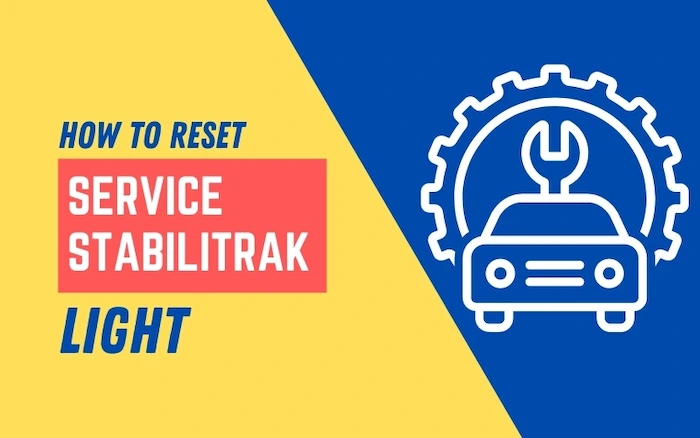How Long Does It Take To Charge An Electric Car
Electric vehicles (EV) have come a long way in the last decade. The technology has improved from the days when you would only consider a hybrid car to have an electric experience to modern stand-alone electrical engines. You no longer need to worry about the car battery not lasting the whole journey. A 2021 model electric car will offer hundreds of miles of the driving range at lower prices. You also do not have to pay over the roof to drive a 2021 electric car.
Electric vehicles are some of the most reliable cars, as they have fewer moving parts, which means minimal maintenance. However, the question still arises on how long does it take to charge an electric car and the range you get once you charge the car. This article will help you better understand what you should expect when buying an EV car.
How Long Does It Take To Charge An Electric Car
When you are looking to buy an EV car, you need to appreciate that almost every car is unique. Some are smaller, efficient, and friendly to use than others. It is imperative to understand how long does it take to charge a car battery before purchasing the vehicle. Generally, the length of time required to recharge your car depends on the energy being used and the charger’s power output. The commercial chargers provide quick charging, enabling you to recharge the battery in less than an hour.
To answer how long does it take to charge an electric car, you will need to consider the types of chargers available, the efficiency of your vehicle, and the variables. That said, you should keep in mind that fully charging the EV battery of most cars, including Tesla, BMW, Volkswagen, Mercedes Benz, Kia, and Hyundai, with a level 1 charger can take between 11 and 30 hours.
Charging your car at level 2 electric car charging stations is faster, taking about four to six hours. It takes even less time to recharge your vehicle with a manufacturer-built fast charger or a third-party fast charger. You can expect to take 40 minutes to an hour when charging your car at Electrify America, ChargePoint, and Tesla Supercharger V3.
7 Things That Affect EV Charging Speed
Opting for an electric car instead of a gasoline-powered vehicle will help you save on refueling costs with savings of about $800 annually. However, the savings are at the expense of quick refilling at a gas station. Depending on the type of electric car charging stations, the shortest period it can take to charge your car fully is about 40 minutes.
Nevertheless, that also depends on many variables that affect how quickly the EV juice is dispensed. Some of the factors that determine how long does it take to charge a car battery include:
1. Charger Type
The charger type determines how long it will take to charge the electric car battery fully. Level 1 chargers usually take longer, usually more than eight hours, while fast-charge stations take less than an hour.
2. EV Connected to a Station
The number of vehicles connected to a station can affect the charge time. Charging your car in a station with several connected vehicles will slower the charging rate due to reduced juice flow.
3. Battery size
The capacity of your EV battery will determine how quickly your car recharges. Cars come with differently-sized electric batteries, which means that it is erroneous to compare two different cars’ charging time unless they share the same battery. The Hyundai Kona base model comes with a 39.2 kWh battery while the Tesla Model X and Model S come with a high-capacity 100 kWh battery. Holding all variables constant, an electric car with a 100-kWh battery will take longer to recharge than a vehicle with a 39.2-kWh battery.
4. Battery Efficiency
Keep in mind that your car’s battery tear and wear will affect the charging speed. Fully depleted batteries tend to charge slower than batteries in good condition. Adopting an EV battery management system will help to protect your battery, keeping it efficient and functional longer. If your battery is worn-out, you should consider changing it to improve efficiency.
5. Juice in The Battery
It will take longer to charge a battery with no charge than it would take to top up a half-full battery. It is an excellent idea to top-up charge your battery once you get to your destination to reduce charging time. Letting your car battery to run dry is not a good idea as you will spend more time recharging the car.
6. Ambient Temperature
Temperatures can affect the charging time of a battery. You will notice slower charging in colder temperatures. Colder temperatures cause electrochemical reactions, making the charging speed slow as mercury drops. It is also worth noting that the range you get from a battery also lowers in cold weather.
7. Time of Day
The power delivery can be affected by the time you charge your EV car. On most occasions, charging your electric vehicle in peak usage hours can slow the charging rate as more people are drawing electricity from the grid.
Types Of Electrical Vehicle Chargers
1. Level 1 Outlet Charger
The level one electric car charging stations are the simplest form of EV charging. Most EV home charging points belong to this category. They feature a standard, three-prong household plug and a connector that plugs into the car. Level 1 EV chargers are easy to use and highly portable. They work with standard 120-volt wall electricity outlets, eliminating the need to hire an electrician for installation. However, they are the slowest EV chargers adding about 40 miles of range in an eight-hour charge.
2. Level 2 Outlet Charger
Most public electric car charging stations fall in this category, but you will also find them at homes. Level 2 chargers require a 240V charging unit circuit. The charging rate depends on the maximum current available and the vehicle’s acceptance rate. In an eight-hour charge, the level 2 charger can add about 180 miles with a typical 30 amp circuit. You will find level 2 chargers at grocery stores, offices, and parking garages. They come with a standard EV connection plug that works with all current vehicles, but you will need an adapter for Teslas.
3. DC Fast Chargers
DC fast charge electric car charging stations are the fastest charging units currently available. They are capable of adding 50 to 90 miles in 30 minutes, depending on the make of your electric car and station’s power capacity. Tesla’s superchargers add up to 170 miles of range in half an hour, but they only work with Tesla cars. They mostly use a 480-volt system, but you can come across 800-volt system superchargers.
The DC superchargers are useful for cars with limited access to home recharging or cars in use most of the day. The fast chargers use three different plug types that are not interchangeable. The Japanese cars use the CHAdeMO standard while most US and European cars use the CCS system. Teslas use a proprietary connector specific to Tesla cars.
How Much Does It Cost To Charge An Electric Vehicle

The cost of charging an electric car varies depending on the cost of electricity per kWh. The national average cost per kWh in the US is around $0.13 with Hawaii being the most expensive at $0.32. That said, you will spend less charging your electric vehicle than fueling a gasoline car.
However, you will need to factor in the additional costs associated with your charger. The level 1 standard chargers come with your vehicle at no additional cost, but you will need to make more investment for a quick charging alternative. Tesla’s Gen 3 wall charger costs about $500, while third-party chargers’ prices range from $400 to $900. You will also pay installation fees that can range between $1,500 and $2,000.
How Long Does An Electric Car Battery Last
A sticking point with electric vehicles is knowing how long does an electric car battery last, with most potential buyers citing the range anxiety as the biggest hurdle to adoption. Unfortunately, there is no single figure that fits all-electric cars. Manufacturers compete on the ability to deliver more range than currently available on the market. Almost every new EV comes with a greater range than its predecessor. Nevertheless, you can expect to get anywhere from 84 miles in a Fiat 500e to 300 miles in a Porsche Taycan or Tesla Model 3.
You have no reason to worry that an EV will not support your driving habits. The 84 miles in Fiat 500e is more than most people will commute in a day, especially when you consider that on average, Americans commute about 16 miles a day. Furthermore, the charging stations are becoming more common, making long-distance travel and all-day car use possible. However, you will need to care for your battery to keep it function efficiently. Batteries have a finite lifespan, making it paramount to understand the battery health to extend its life span.
A Further Illustration of How a Car Battery Can Last
In an attempt to keep batteries functioning optimally longer, the level 2 and fast chargers usually fast-charge a battery to 80 percent capacity and then slow the charging speed, taking advantage of the grace capacity. However, it is worth noting that your battery’s performance will decrease over time, lowering the driving range. You also need to note that the frequency of recharging, charging station speed, load levels, battery age, and temperature can affect your battery’s performance.
Nevertheless, most EV batteries come with an 8-year, 100,000-mile manufacturer warranty, but that does not mean that you will not experience loss of capacity and driving range over time. Your driving style will also determine how long does an electric car battery last. An aggressive, fast driver depletes the battery quicker than a gentler driver. Furthermore, the judicious use of the climate control system can help to preserve the range. Using heated seats as opposed to blasting hot air through the vents can help to increase the distance.
The Characteristics And Functionality Of An Electric Car Battery
The battery is the most important component of an electric car. It functions as the energy accumulator that stores electricity for transmission to the electric engine. Quality batteries make electric cars sustainable. A top car with a poor quality battery will struggle to sell as it is not functional. Some of the concerns buyers have with EV batteries include the charging time, the distance a vehicle can travel before needing a recharge, and the price. The EV battery performance has improved over the last decade, eliminating the buyer’s fear of getting stuck on the roadside due to a limited range. The charging time and durability have also improved, enhancing the efficiency and life cycle.
If you are looking to buy an EV battery for your car, you should put the following into consideration:
- Density: Density refers to the amount of energy the battery stores in relation to its weight. Batteries with greater density have greater storage capacity, ensuring a more extended driving range.
- Voltage: Voltage is the battery’s power per kilogram of the battery weight, expressed in Watts per kg (W/kg). An EV battery with greater power offers more excellent performance.
- Life cycle: The life cycle highlights the durability of the battery. It is the number of times you can drain and recharge the battery before needing replacement. A battery with more cycles will last longer.
- Efficiency: Efficiency is a measure of performance. It is the percentage of energy the battery can deliver as per the power introduced into the charging process.
- Charging speed: The charging rate will depend on the model of the car and the type of charging, whether rapid, fast, or slow.
Tips To Help You Extend The Life Cycle Of An Electric Car Battery
- Use smart chargers to charge your car, and if possible, opt for a slow charger. Frequent rapid charging can shorten battery life.
- Use the brakes more to get a more extended range. The braking system helps to charge the battery.
- Accelerate gently and avoid parking in the sun to prevent triggering the thermal management system
- Manage the battery charge capacity effectively. Avoid fully draining and recharging the battery every time to prolong its life.
The 5 Cheap Electrical Cars With The Best Range
1. 2020 Tesla Model 3
- EPA range – 250 miles
- EPA consumption – 24 kWh/100 mi
The 2020 Tesla Model 3 is an efficient electric vehicle that is luxurious and fun to drive. At an MSRP range of between $37,990 and $54,990, the Tesla Model 3 is a top-rated luxury electric car that is affordable. It offers decent space for its size and has an interior design that makes it a sporty electric vehicle. The over-reliance on a touch screen interface for vehicle controls can be a bit distracting, but you will fall in love with the car once you get a chance to drive it. Buying this EV gives you access to Tesla proprietary supercharger changing network as well as some of the best semi-automated driving assistance features.
Tesla Model 3 electric car comes in three trims, the standard range plus, long-range and performance. If you need a more affordable option, you can call the company to request the standard range trim. Tesla updates Model 3 regularly as opposed to yearly, ensuring efficiency at all times. The standard range plus features 250 miles of range, a glass roof, rear-wheel drive, 15-inch touch screen, and power-adjustable front seats.
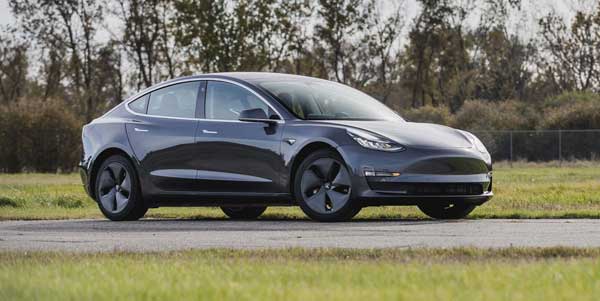
Pros:
- It is an affordable luxury electrical car
- Exceptional range, performance, and handling
- It has more technologically advanced features than most competitors
- Tesla supercharger stations are readily available
Cons:
- It does not support Android Auto and CarPlay apps
2. 2020 Kia Niro EV
- EPA range – 239 miles
- EPA consumption – 30 kWh/100 mi
The 2020 Kia Niro EV gives you the feel of Kia almost an SUV hatchback with strong electric motors for a better driving experience. It comes with friendly infotainment and creative interior storage solutions. At MSRP of between $39,090 and $44,590, Kia Niro EV has an impressive amount of technology features, safety features, and roomy seating. The car has stable handling and quick acceleration, making the Niro EV more fun to drive a car.
The 2020 Kia Niro EV offers plenty of power, immediate and smoothly, resulting in a comfortable drive. It has quick acceleration, reaching 60 mph in 6.8 seconds. The braking is smooth and consistent, but the one-pedal driving will not bring you to a complete stop unless you use the steering paddle. The car comes with EV-specific screens that display driving data and range. The 2020 Kia Niro EV comes in two trims, the EX and EX premium.

Pros:
- It offers a decent range
- Many standard safety features
- It is fun to drive with secure handling and quick acceleration
Cons:
- The all-wheel-drive is not available
3. 2020 Hyundai Kona Electric
- EPA range – 258 miles
- EPA consumption – 28 kWh/100 mi
The 2020 Hyundai Kona Electric is a top-rated car with an impressive electric range. At MSRP of between $37,190 and $45,400, Hyundai Kona Electric offers a driving experience of higher-priced luxury models. The car has a pleasant interior and comes with an SAE combo charger for quicker charging between drives. The Kona Electric is fun to drive with good acceleration and comfortable handling on turns. You will fall in love with the available safety and technology features as well as the standard fast-charging capability.
The 2020 Hyundai Kona Electric is available in three trims, the SEL, Limited and ultimate. All models feature a powerful 64-kWh battery pack that runs a 150-kW electric motor, delivering 201 horsepower and 291 lb-ft of torque. The SEL base model has great features, including proximity entry, push-button start, automatic climate control, a 7-inch infotainment touch screen, automatic climate control, and a DC fast-charging port. The trim also supports Android Auto and Apple CarPlay.
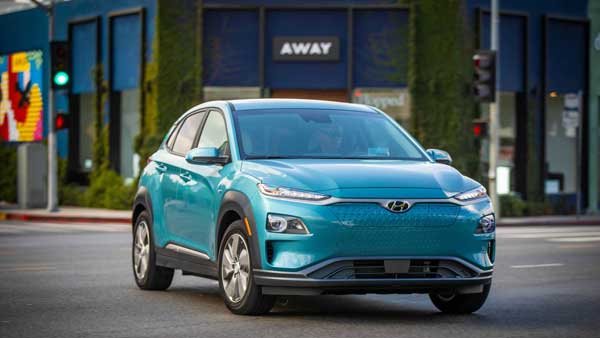
Pros:
- It delivers a long driving range
- It offers quick acceleration and sharp handling
- Many available standard features
Cons:
- Small legroom
- Availability restricted to a few states
4. 2020 Chevrolet Bolt EV
- EPA range – 259 miles
- EPA consumption – 29 kWh/100 mi
The 2020 Chevrolet Bolt EV is a leader in the electric vehicle platform. Before the Kona and Niro graced the market, Chevrolet Bolt was the only non-Tesla electric car to offer an electric driving range of close to 250 miles. At MSRP of between $36,620 and $41,020, the 2020 Chevrolet Bolt EV gains 21 miles in coverage to a total estimate of 259 miles. It further features new, higher-definition rearview and surround-view cameras.
The 2020 Chevrolet Bolt EV is available in two trims, the LT and premier. Both options run on a 66-kWh lithium-ion battery pack that powers a single electric motor, delivering 200 hp and 266 lb-ft in a single-speed transmission. The base model has a host of features, including a 10.2-inch color touch screen with Apple CarPlay and Android Auto support, ambient interior lighting, keyless start, and a high-definition rearview camera.
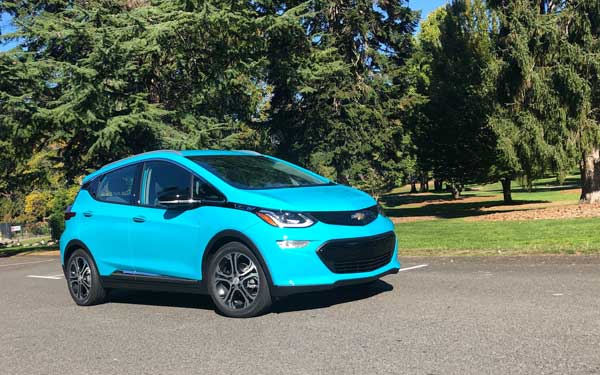
Pros:
- It delivers impressive miles range
- Spacious cabin
- It has comfortable handling and quick acceleration
Cons:
- The front seats are narrow and do not have cushion depth
- The ride is not comfortable on rough roads
- It does not have built-in navigation maps
5. 2020 Nissan Leaf EV
- EPA range – 149 to 226 miles
- EPA consumption – 30 to 32 kWh/100 mi
The redesigned 2020 Nissan Leaf is a better car than its predecessor, offering a quieter, more comfortable ride. At the MSRP range of between $31,600 and $43,900, the 2020 Nissan Leaf sees more airbags added for front and rear occupants. The Android Auto and Apple CarPlay are standard in the 2020 model, as well as the Nissan Safety Shield 360. The 2020 Nissan Leaf incorporates years of design in the market to achieve incredible customer satisfaction levels. Nissan Leaf stands out as the first mass-market electric vehicle in America in 2011.
The 2020 Nissan Leaf is available in two electric hatchback models, the regular Leaf and the Leaf plus. The difference lies in the battery and the electric motor. The regular Leaf runs on a 40-kWh battery that powers a 147-hp motor, providing you with a range of 150 miles. The Leaf plus model runs on a bigger 60-kWh battery pack that powers a powerful 214-hp electric motor, delivering a range of 226 miles.
The Leaf EV comes in three trims, the S, SV, and SL. The base S trim comes with features that include; keyless ignition and entry, automatic climate control, a tilt-only steering wheel, a height-adjustable driver’s seat, Apple CarPlay, Android Auto, and an 8-inch touch screen. It further comes with Safety Shield 360 safety pack that includes lane-keeping assist, blind-spot monitor, and forward and rear collision warning with automatic emergency braking.
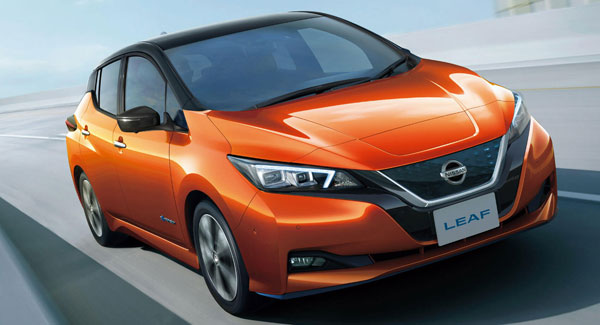
Pros:
- It features quick, smooth acceleration
- It delivers excellent mileage
- Offers a quiet driving experience
Cons:
- You do not get to own the car
- Despite low monthly installments, you do not get the cash from the car’s sale
- Limited mileage since driving over the allocated limit attracts charges
- Pay high charges for car damages
- Prices are often minus VAT
Conclusion
Electric vehicles have come a long way in the last decade. You can get as much as over 200 miles with a single charge. The public chargers are also more readily available if you need to use an EV car for a long-distance drive.
Frequently Asked Questions (FAQs)
What Is The Fastest Charging Electric Car?
The speed of charging an electric car depends on several factors, including the charger’s type, with level 1 chargers being the slowest and fast chargers being the fastest. It also depends on the size of the battery, with larger capacity batteries taking longer. Further, the number of EV cars being charged simultaneously can affect the rate of charging. Charging an electric car can take longer in electricity peak-use times, and the charging circuit with a 120-volt system being slower than 240 and 480-volt systems. That said, some of the fastest charging electric cars include the Tesla Model 3 Long Range and Porsche Taycan with a 480-volt charging system.
How Often Do You Need To Charge An Electric Car?
How often you need to charge an electric car depends on your daily driving mileage. With most EV offering over 150 miles range when fully charged, it is possible to take a few days before recharging for short travels. However, it is better to top up your EV every time you drive to reduce recharge time.
Do Electric Cars Lose Charge When Parked?
It depends. The EV batteries can handle extended periods of inactivity well without losing charge. However, whether your EV car will lose charge when parked depends on how well you take care of the battery and whether you are following manufacturer guideline. Some manufacturers recommend that you keep the battery unplugged to enable it to go into a sleep state, but that varies among cars.
Should I Charge My Electric Car Every Night?
It is not necessary as it depends on the juice in your battery. However, it is a good idea to top up your battery every time you use the car with a slow charging charger.
What Happens If Your Electric Car Runs Out Of Battery?
If an electric car runs out of battery during a drive, it will run to a halt in the same way a gasoline engine behaves once it is out of gas. However, letting the battery run out can affect the performance of your battery and its durability. It is not a good idea to let the battery go below 10 percent without recharging.

